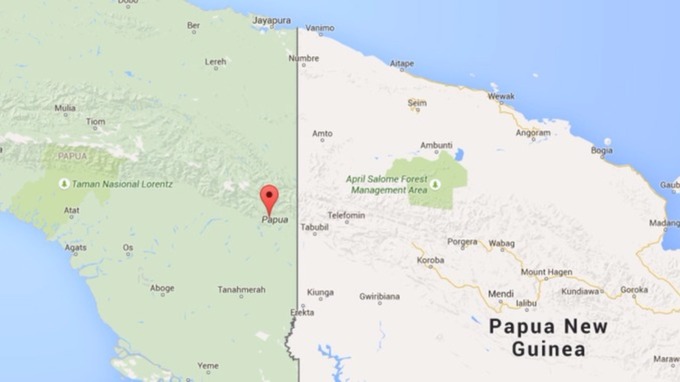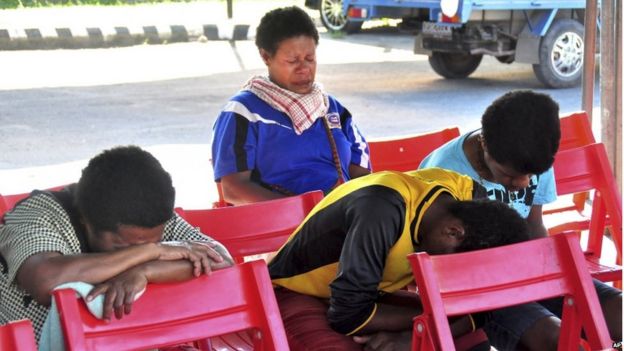Airport
Indonesia Trigana plane crash: Remains of 54 dead found in Papua.

Indonesian rescue workers have reached the crash site of a passenger plane that went down in a mountainous area with 54 people on board, a senior official said Tuesday.
The teams on the ground have so far seen at least 38 bodies at the scene and haven’t found any survivors, said Bambang Soelistyo, the head of Indonesia’s search and rescue agency. Helicopters are being deployed to the densely forested area in the eastern Indonesian province of Papua to begin the evacuation process.
The aircraft’s black box flight recorder, which should provide investigators with some answers, was found in the early afternoon. The device will be taken to Oksibil town tomorrow, depending on the weather,
Its also been reported that An Indonesian passenger plane that crashed at the weekend in Papua was transporting about 6.5 billion rupiah ($470,000) in cash to distribute to poor families in the eastern province, a post office official said.





pic courtesy : BBC
Indonesia’s state search and rescue agency had reported that it has lost contact with the aircraft earlier on Sunday.
In a tweet posted on Sunday, Bandan SAR Nasional or National Agency Search and Rescue said the Trigana Air flight had 54 passengers on board. The passengers include 44 adults, two children, three toddlers and five crew members.
According to the tweet, the aircraft lost contact while flying over the remote eastern Papua region at 2:55pm local time. reporting from Jakarta, said the plane was scheduled to land at a small airport in Oksibil at around 3pm local time (06:00 GMT) plane was scheduled to land at a small airport in Oksibil at around 3pm local time (06:00 GMT).Oksibil is a remote town near the country’s border with Papua New Guinea.
The plane was flying between Jayapura’s Sentani Airport and Oksibil, due south of Jayapura, the capital of Papua province. Indonesia’s transport ministry spokesman J.A. Barata confirmed the plane had lost contact and said it was supposed to arrive at Oksibil airport just after 4.00pm AEST.
According to the Aviation Safety Network, an online database, the ATR 42-300 had its first flight 27 years ago. ATR is a joint venture between Airbus and Alenia Aermacchi, a subsidiary of Italian aerospace firm Finmeccanica .
Trigana has been on the EU blacklist of banned carriers since 2007. Airlines on the list are barred from operating in European airspace due to either concerns about its safety standards, or concerns about the regulatory environment in its country of registration.
The airline has a fleet of 14 aircraft, according to the airfleets.com database. These include 10 ATR aircraft and four Boeing 737 classics. These have an average age of 26.6 years, according to the database.
Trigana has had 14 serious incidents since it began operations in 1991, according to the Aviation Safety Network’s online database. Excluding this latest incident, it has written off 10 aircraft. Indonesia has a patchy aviation safety record and has seen two major plane crashes in the past year, including an AirAsia flight that went down in the Java Sea, killing all on board.
That crash prompted the government to introduce regulations aimed at improving safety. Indonesia’s president promised a review of the ageing air force fleet in July after a military transport plane crashed in the north of the country, killing more than 100 people.
Reported source : reuters

Airport
Top 10 Largest Airports in the World by Size

When it comes to the world’s busiest and largest airports, size matters—not just in terms of the area they cover, but also in the volume of passengers they handle and the number of flights they accommodate.
As air travel continues to grow, airports around the globe are expanding and upgrading to meet increasing demand.
Qatar Airways Announces New Flights to Hamburg, resume services to Venice:Click
In 2024, several airports stand out for their impressive size and capacity. This article takes a closer look at these massive aviation hubs, highlighting their key features and what makes them the largest airports in the world today.
Country Airport Area (sq km) Saudi Arabia King Fahd International Airport 776 United States Denver International Airport 135 Malaysia Kuala Lumpur International Airport 100 Turkey Istanbul Airport 76 China Beijing Daxing International Airport 46 Egypt Cairo International Airport 36 Thailand Suvarnabhumi Airport 32 Spain Adolfo Suárez Madrid-Barajas Airport 30 Canada Edmonton International Airport (YEG) 28 Netherlands Amsterdam Airport Schiphol 27 Australia Brisbane International Airport 27 Germany Frankfurt Airport 23 India Rajiv Gandhi International Airport 22
King Fahd International Airport, Saudi Arabia – Spanning a staggering 776 square kilometers, King Fahd International Airport is the largest airport in the world by area. Its vast expanse reflects its crucial role as a major hub in the Middle East.
Denver International Airport, United States – Covering 135 square kilometers, Denver International Airport ranks second in size. Known for its distinctive peaked roof and extensive facilities, it serves as a major gateway in North America.
Kuala Lumpur International Airport, Malaysia – With an area of 100 square kilometers, Kuala Lumpur International Airport is a key international hub in Southeast Asia, offering extensive services and connectivity.
Top 10 Busiest Airports in the World for 2023:Click here
Istanbul Airport, Turkey – Istanbul Airport covers 76 square kilometers. This relatively new airport has quickly become one of the largest and busiest, positioning itself as a central point for travel between Europe and Asia.
Beijing Daxing International Airport, China – Beijing Daxing International Airport, with 46 square kilometers, is one of the newest major airports, featuring an impressive design and extensive facilities to handle growing passenger traffic.
-

 Travel1 week ago
Travel1 week agoAir India to Expand US Operations with Three New Routes After a Decade
-

 Travel2 weeks ago
Travel2 weeks agoWhy We Should Avoid These Stamps in a Passport
-

 Airlines1 month ago
Airlines1 month agoInvestigations Reveal Fake Chinese Titanium in Boeing and Airbus Jets
-

 Tech4 weeks ago
Tech4 weeks agoChina’s CATL Plans 1,800-Mile Electric Plane Launch by 2027
-

 Airport3 days ago
Airport3 days agoTop 10 Largest Airports in the World by Size
-

 Aerospace4 weeks ago
Aerospace4 weeks agoChina’s Fighter Jets Turn Wings into Autonomous Drones
-

 Airlines4 days ago
Airlines4 days agoAir India Rolls Out A350s for Delhi-New York JFK and Newark Routes
-

 Defence3 weeks ago
Defence3 weeks agoBoeing Enhances Chinook with New Engines and Block II Upgrades at $96 Million







